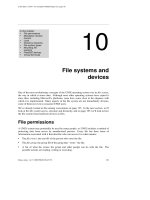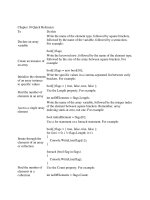Discovering Computers - Chapter 10: Database Management
Bạn đang xem bản rút gọn của tài liệu. Xem và tải ngay bản đầy đủ của tài liệu tại đây (4.22 MB, 42 trang )
Chapter 10
Database
Management
Chapter 10 Objectives
Define the term, database
Differentiate between a file processing
system approach and the database approach
Identify the qualities
of valuable information
Discuss the functions
common to most DBMSs
Explain why data is important
to an organization
Describe characteristics of
relational, object-oriented, and
multidimensional databases
Discuss the terms character,
field, record, and file
Explain how to interact with Web databases
Identify file maintenance techniques
Discuss the responsibilities of
database analysts and administrators
Next
Data and Information
What is a database?
Collection of data
organized so
you can access,
retrieve, and
use it
Database software
allows you to
Create
database
Add,
change,
and delete
data
p. 514
Database software
also called database
management system
(DBMS)
Sort
and
retrieve
data
Create
forms
and
reports
Next
Data and Information
How are data and information related?
Data is raw facts
Information is data that is organized
and meaningful
Computers
process
data into
information
Step 2. The
computer extracts
the member data
from disk.
receipt
processing
Step 1. The member
data, including a
photograph, is entered
and stored on the hard
disk.
p. 514 Fig. 10-1
data stored on disk
Step 3. The receipt is
created and printed.
Next
Data and Information
What is data integrity?
Degree to which data is
correct
Garbage in, garbage
out (GIGO)—computer
phrase that means you
cannot create correct
information from
incorrect data
Garbage in
Garbage out
Data integrity
is lost
p. 516
Next
Data and Information
What are the qualities of valuable information?
Accurate
Verifiable
Timely
Organized
Accessible
Useful
Cost-effective
p. 516 - 517
Next
The Hierarchy of Data
What is a hierarchy?
Database contains files, file contains records, record
contains fields, field contains characters
p. 517 Fig. 10-2
Next
The Hierarchy of Data
What is a field?
Combination of one or more
characters
Smallest unit of data user accesses
p. 518 Fig. 10-3
Field size defines the maximum
number of characters a field can
contain
Field name uniquely identifies each
field
Data type specifies kind of data field
contains
Next
The Hierarchy of Data
What are common data types?
Text
Numeric
(also called
alphanumeric)—letters,
numbers, or special
characters
AutoNumber
numbers
only
unique number automatically
assigned to each new record
Currency
dollar and cent amounts or
numbers containing decimal
values
Yes/No
(also called
Boolean)—only the
values Yes or No (or
True or False)
p. 518
Date
Memo
month, day, year, and
sometimes time
lengthy text entries
Hyperlink
Web address that links to
document or Web page
Object
(also called BLOB for binary large
object)—photograph, audio, video,
or document created in other
application such as word
processing or spreadsheet
Next
The Hierarchy of Data
What is a record?
Group of
related fields
Key field, or primary key,
uniquely identifies each record
p. 519
Next
The Hierarchy of Data
What is a data file?
Collection of related records stored on disk
records
p. 519
Member ID
First Name
Last Name
Address
City
State
2295
Donna
Vandenberg
1029 Wolf Avenue
Montgomery
AL
2928
Shannon
Murray
33099 Clark Street
Montgomery
AL
3376
Adrian
Valesquez
15 Duluth Street
Prattville
AL
3928
Jonah
Weinberg
P.O. Box 45
Clanton
AL
4872
Marcus
Green
22 Fifth Avenue
Auburn
AL
key
field
fields
Next
Maintaining Data
What is file maintenance?
Procedures that keep data current
Adding records
Changing records
Deleting records
p. 520
Next
Maintaining Data
Why do you add records?
Add new record when you obtain new data
p. 520 Fig. 10-5
Next
Maintaining Data
Why do you change records?
Correct inaccurate data
Update old data
p. 521 Fig. 10-6
Next
Maintaining Data
Why do you delete records?
When record no longer is needed
Some programs remove record immediately,
others flag record
p. 522 Fig. 10-7
Next
Maintaining Data
What is validation?
Process of comparing data with a set of rules
to find out if data is correct
Reduce data entry errors and enhance data
integrity before program writes data on disk
p. 522 Fig. 10-8
Next
Maintaining Data
What are the types of validity checks?
Check Digit
number(s) or
character(s)
appended to or
inserted into a
primary key value
to confirm
accuracy of
primary key value
Click to view Web
Link, click Chapter 10, Click
Web Link from left
navigation, then click
Check Digits below Chapter 10
p. 523
Alphabetic/
Numeric Check
ensures correct
type of data
entered
Completeness
Check
verifies that a
required field
contains data
Range Check
determines
whether number is
within specified
range
Consistency
Check
tests for logical
relationship
between two or
more fields
Next
File Processing Versus Databases
What is a file processing system?
Each
department or
area within
organization
has own set of
files
Records in one
file may not
relate to
records in any
other file
May have
weaknesses
Data
redundancy—
same fields
stored in
multiple files
p. 524
Isolated
data—data
stored in
separate files
so it is
difficult to
access
Next
File Processing Versus Databases
What is the database approach?
Many programs and users can share data in database
Secures data so only authorized users can access
certain data
p. 524 Fig. 10-9
Next
File Processing Versus Databases
What are the strengths of the database approach?
Reduced
data
redundancy
Improved
data
integrity
Shared
data
Easier
access
p. 525
Reduced
development
time
Next
File Processing Versus Databases
How do a database
application and a
file processing
application differ
in the way they
store data?
p. 525 Fig. 10-10
Next
Database Management Systems
What are popular database management systems (DBMSs)?
Click to view Web
Link, click Chapter 10,
Click Web Link from left
navigation, then click
Database Management System
below Chapter 10
p. 526 Fig. 10-11
Next
Database Management Systems
What is a data dictionary?
Contains data about each file in database and each
field within those files
Click to view Web
Link, click Chapter 10, Click
Web Link from left
navigation, then click
Data Dictionary below Chapter
10
p. 527 Fig. 10-12
Next
Database Management Systems
Step 1. Select the fields you want
What is a query?
Request for specific data from
a database
Query language consists of
simple, English-like statements
that allow users to specify data
to display, print, or store
to display in the resulting query.
Step 2. Assign a name to the
query, so you can open it later.
Step 3. View query on the screen.
p. 528 Fig. 10-13
Next
Database Management Systems
What is a query by example (QBE)?
Program retrieves records that match criteria
entered in form fields
Has a graphical user interface that assists users
with retrieving data
Query by example screen
criteria
Query results
p. 528 Fig. 10-14
Next









